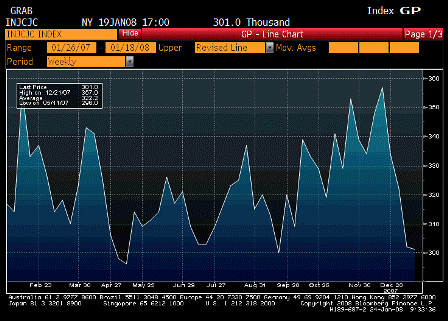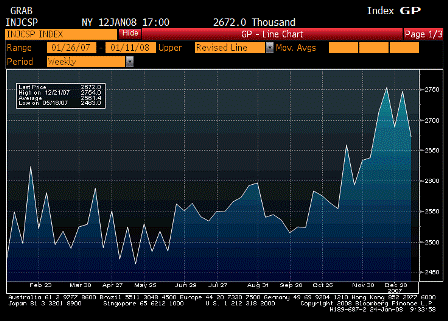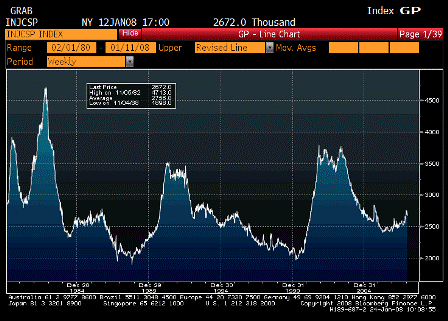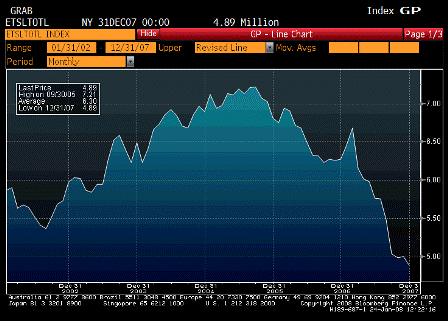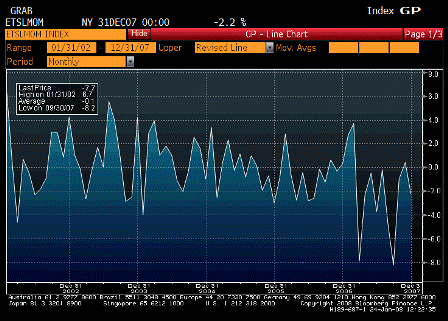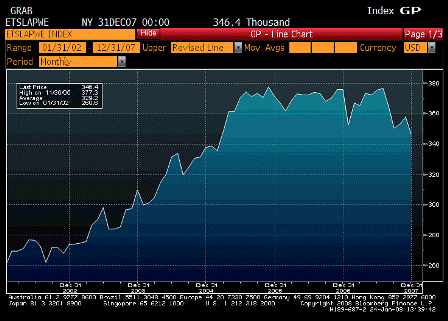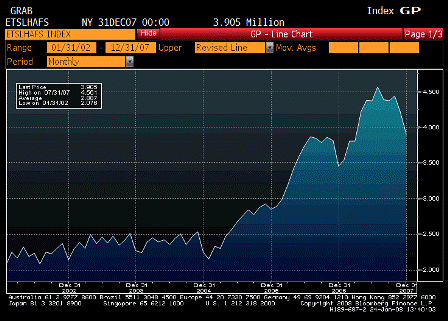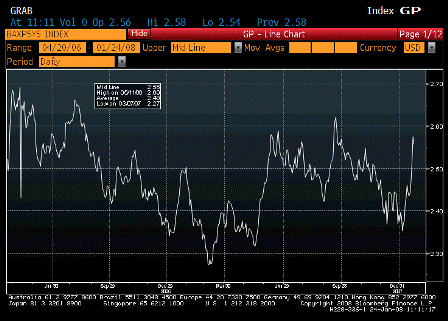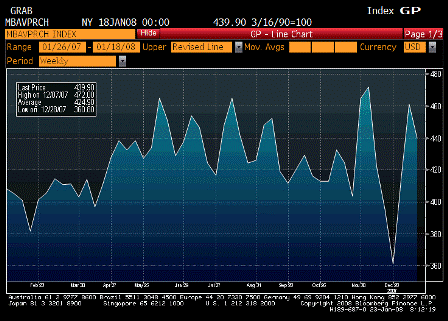(an email)
On Jan 23, 2008 8:51 PM, Joshua wrote:
>
> Economy is in dire condition?!?!?! Look at today’s earnings reports and
> forecasts…anecdotal, but not so dire at all!
Yes, they’ve been forecasting recession for about a year and it keeps getting put off a quarter.
Now the term is morphing to ‘growth recession’ which mean growth slows for a few quarters.
Hardly the stuff of rate cuts for a mainstream economist when inflation is ripping.
warren
> Subject: BTIG Earnings Recap for January 23, 2008
>
> Stocks staged a late day rally (biggest in 2 months) on a report NY
> regulators met with banks to discuss aid for bond insurers. Trading on
> earnings (6:15pm): COF +0.30 (+0.7%), CTXS -1.02 (-3.2%), EBAY -1.63
> (-6.7%), FFIV +3.91 (+19.4%), GILD -0.81 (-1.8%), ISIL -0.72 (-3.1%) , NFLX
> -0.06 (-0.25%), PLCM +1.72 (+7.7%), QCOM +2.67 (+7.3%), QLGC +0.17 (+1.3%),
> SANM +0.04 (+2.8%), SYMC +1.40 (+9.1%) and WDC +1.36 (+5.5%). Expected to
> report in the morning: ABC, BAX, COL, CY, DHR, ED, F, HSY, KMB, LCC, LMT,
> MHP, NOK, NOC, NUE, POT, RESP, SPWR, T, TXT, UNP and XRX. Economic data for
> tomorrow includes Initial Claims for 1/19, December Existing Home Sales and
> Crude Inventories for 1/19.
>
> TickerAnnouncementNote
> AMCC+ 1c better, revs better
> AVCT+ 10c better, revs inline
> BKHM+ 5c better, revs betterguides Q3 revs inline
> CAVM+ 1c better, revs better
> CBT+ 24c better, revs better
> CHIC+ 1c better, revs inlineguides Q2 EPS inline
> CNS+ 2c better, revs better
> CTXS+ 6c better, revs betterguides Q1 inline, FY08 inline
> GILD+ 1c better, revs inline
> HXL+ 1c better, revs betterguides FY08 inline
> ISIL+ 1c better, revs betterguides Q1 EPS, revs inline
> KNX+ 1c better, revs better
> LSI+ 6c better, revs betterguides Q1 inline
> MOLX+ 2c better, revs betterguides Q3 EPS inline, revs above
> NFLX+ 10c better, revs inlineguides Q1 EPS inline, revs above; FY08 EPS
> above, revs inline
> NVEC+ 6c better, revs better
> PLCM+ 3c better, revs better
> PLXS+ 2c worse, revs inlineguides Q2 EPS above, revs above
> PRXL+ 1c better, revs betterguides Q3 EPS inline, revs above; guides FY08
> EPS, revs above
> QLGC+ 3c better, revs better
> QTM+ inline, revs lower
> RGA+ 6c better, revs lowerguides FY08 EPS above
> RKT+ 4c better, revs better
> RYL+ 53c (ex-items), vs loss of 17c (First Call), revs better
> SANM+ 1c better, revs betterguides Q2 EPS inline, revs above
> SXL+ 10c better, revs better
> SYMC+ 4c better, revs betterguides Q4 EPS above, revs above
> TSS+ 3c better, revs inlineguides FY08 above, revs inline
> VAR+ 3c worse, revs betterissues Q2, FY08 guidance
> VARI+ 2c better, revs better
> WDC+ 31c better, revs better
> EFII= inline, revs inlinereaffirms Q1 guidance
> FFIV= inline, revs inlineannounces share repurchase up to $200mln
> SRDX= inline, revs better
> ACXM- 2c worse, revs lowerissues FY08 guidance
> CBST- 1c worse, revs inline
> CLDN- 1c worse, revs better
> COF- 3c worse, revs lower
> DGII- 3c worse, revs inlinereaffirms FY08 inline
> EBAY- 4c better, revs betterguides Q1 EPS, revs below; FY08 EPS inline, revs
> below
> MRCY- 9c better, revs inlineguides Q3 EPS, revs below, FY08 EPS, revs below
> MTSC- 10c worse, revs betterreaffirms FY08 guidance
> NE- 1c worse, revs inline
> PSSI- 1c worse, revs inlinereaffirms FY08 EPS guidance
> PTV- 2c better, revs betterguides Q1 EPS below, FY08 EPS, revs inline
> QCOM- 1c worse, revs betterguides Q2 EPS, revs inline; reaffirms FY08 EPS,
> guides FY08 revs inline
> RJF- 11c worse, revs lower
> SOV- 4c worse
> SYK- inline, revs betterguides FY08 inline
> WSTL- loss of 4c vs loss of 6c (may not be comp), revs slightly betterguides
> Q4 below
>
♥

